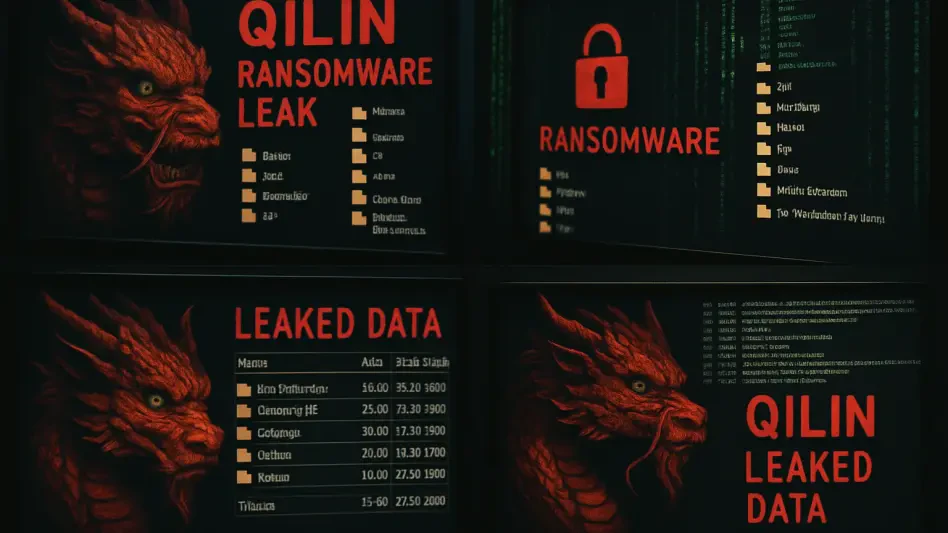In a shocking development that has rattled the cybersecurity landscape, the Qilin ransomware group, a formidable force in the realm of digital crime, has been thrust into the spotlight due to a dramatic internal fallout. On July 31 of this year, login credentials for the group’s affiliate management panel surfaced online, providing an unprecedented look into the inner workings of a ransomware-as-a-service (RaaS) operation. This breach, driven by a heated dispute within the group’s ranks, exposes not only the operational frailties of such criminal networks but also the fragile alliances that hold them together. The incident serves as a stark reminder of how swiftly trust can erode in the shadowy underworld of cybercrime, where betrayal can be as damaging as any external threat. As details of this leak continue to unfold, the cybersecurity community finds itself at a crossroads, grappling with both the risks and opportunities presented by this rare glimpse into a notorious ransomware operation.
Internal Strife and Competitive Sabotage
Conflict with Affiliate “hastalamuerte”
The root of this explosive breach lies in a bitter financial disagreement between the Qilin ransomware group and one of its affiliates, known by the alias “hastalamuerte.” This affiliate publicly accused Qilin of orchestrating an exit scam, alleging a staggering loss of $48,000 due to deceptive practices by the group’s leadership. Such accusations are not uncommon in the volatile world of cybercrime, where financial stakes are high and trust is often in short supply. However, this particular dispute escalated beyond mere words, as the fallout shattered the fragile bond between Qilin and its affiliate. The public airing of grievances on underground forums not only damaged the group’s reputation but also set the stage for a catastrophic breach of sensitive information. This incident highlights how financial disputes can act as a catalyst for operational breakdowns, exposing vulnerabilities that are otherwise carefully guarded in these illicit enterprises.
Delving deeper into the conflict, the rift with “hastalamuerte” reveals the precarious nature of partnerships within ransomware groups. The affiliate’s decision to voice their grievances openly suggests a profound breakdown in communication and mutual benefit, which are often the glue holding such arrangements together. The $48,000 loss, while significant, likely represents only a fraction of the broader financial dealings at play, pointing to deeper systemic issues within Qilin’s structure. This internal strife not only jeopardized the affiliate’s operations but also created a ripple effect, drawing unwanted attention to the group’s activities. As trust dissolved, the stage was set for external actors to exploit the situation, turning a private disagreement into a public spectacle. This scenario underscores the inherent risks of operating in a space where loyalty is often overshadowed by greed, and where a single misstep can lead to devastating consequences for an entire criminal network.
Role of Rival “Nova”
Adding another layer of complexity to this incident is the involvement of a rival cybercriminal known as “Nova,” who is affiliated with a competing ransomware operation. Seizing on the discord within Qilin, Nova took the drastic step of leaking the group’s affiliate panel credentials on dark web forums, effectively weaponizing the internal conflict for competitive gain. This act of sabotage is emblematic of the ruthless dynamics that define the ransomware ecosystem, where groups are just as likely to target each other as they are to attack legitimate organizations. Nova’s actions not only amplified the damage to Qilin but also sent a clear message about the cutthroat nature of this underground market. Such inter-group rivalry reveals how fragile the balance of power can be, with each player constantly seeking an edge over their adversaries.
Beyond the immediate impact of the leak, Nova’s role in this saga sheds light on the broader competitive landscape of cybercrime. By publicly exposing Qilin’s operational details, Nova likely aimed to undermine the group’s credibility among potential affiliates and clients, thereby redirecting business to their own operation. This calculated move illustrates how leaks can serve as strategic tools in a highly competitive environment, where information is as valuable as any ransom payment. Furthermore, the public nature of the disclosure on dark web platforms ensures that the damage to Qilin extends beyond mere operational setbacks, potentially eroding trust across the wider cybercriminal community. This incident serves as a potent example of how rivalries can exacerbate vulnerabilities, turning internal disputes into opportunities for external actors to strike with precision and intent.
Qilin’s Operational Scale and Impact
High-Profile Targets and RaaS Model
Qilin has established itself as a formidable threat in the ransomware domain, having targeted over 600 victims since its emergence. Among its high-profile victims are critical institutions such as the Palau Health Ministry, Japan’s Utsunomiya Cancer Center, and Lee Enterprises in the United States, demonstrating the group’s audacious reach across sectors like healthcare and media. These attacks have caused significant disruptions, often exploiting sensitive data and critical infrastructure to maximize impact. The breadth of Qilin’s victimology underscores the global nature of the ransomware threat, where no organization, regardless of location or function, is immune. The group’s ability to repeatedly strike such prominent targets highlights the urgent need for robust defenses against these pervasive digital assaults.
Central to Qilin’s success is its adoption of the ransomware-as-a-service (RaaS) model, which significantly amplifies its destructive potential. By providing affiliates with access to shared tools, infrastructure, and expertise, Qilin enables a network of independent operators to carry out attacks under its banner. This decentralized approach not only scales the group’s operations but also diversifies its attack vectors, making it harder for defenders to predict and mitigate threats. The RaaS model fosters a collaborative yet exploitative environment, where affiliates like “hastalamuerte” can leverage Qilin’s resources to target a wide array of victims. However, as this leak demonstrates, the same model that empowers affiliates can also become a liability when internal disputes arise, exposing the very systems that fuel the group’s success. This duality reflects the complex interplay of innovation and risk inherent in modern ransomware operations.
Sophisticated Toolkit Exposed
The leaked data from Qilin’s affiliate panel offers a detailed look at the advanced toolkit employed by “hastalamuerte,” revealing the technical sophistication behind the group’s attacks. Hosted partly on GitHub, this arsenal includes tools like Themida-packed Mimikatz for credential harvesting, NetExec for exploiting Active Directory environments, and XenoRAT for maintaining remote access to compromised systems. Each component serves a specific purpose in the attack lifecycle, from initial breach to sustained control over victim networks. The use of such specialized tools indicates a high level of expertise and adaptability, allowing affiliates to tailor their approaches to different targets. This glimpse into Qilin’s technical capabilities serves as a sobering reminder of the challenges faced by defenders in countering these threats.
Further analysis of the toolkit uncovers additional layers of complexity, including the integration of cryptocurrency tools that suggest potential money laundering activities. Features like the Bitkub API point to financial schemes possibly targeting Thai markets or facilitating illicit transactions. Additionally, the affiliate exploited known vulnerabilities such as CVE-2021-40444 and the Follina exploit (CVE-2022-30190), demonstrating a comprehensive strategy that spans reconnaissance, infiltration, and data exfiltration. The presence of evasion tools like RealBlindingEDR, designed to bypass antivirus software, further illustrates the meticulous planning behind these operations. This detailed exposure of Qilin’s methods not only highlights the group’s technical prowess but also provides a roadmap of sorts for understanding how modern ransomware attacks are orchestrated, offering critical insights into the evolving nature of cyber threats.
Defensive Opportunities and Cybersecurity Implications
Intelligence Goldmine for Defenders
The exposure of Qilin’s affiliate panel credentials, while alarming, presents a unique opportunity for cybersecurity professionals to strengthen their defenses. The leaked data includes specific detection signatures, behavioral patterns, and details of exploited vulnerabilities that can be directly applied to bolster security measures. For instance, identifying unusual usage of tools like NetExec or Themida-packed executables can help organizations detect potential intrusions at an early stage. Moreover, understanding the specific vulnerabilities targeted by Qilin affiliates allows for prioritized patching and monitoring efforts. This wealth of actionable intelligence transforms a breach into a defensive asset, enabling security teams to anticipate and counter similar attacks with greater precision and effectiveness.
Beyond immediate detection capabilities, the leak offers a broader strategic advantage by revealing the operational mindset of Qilin’s affiliates. The detailed breakdown of their attack lifecycle—from initial credential theft to sustained network access—provides a clearer picture of how ransomware groups prioritize targets and exploit weaknesses. This understanding can inform the development of more robust incident response plans, ensuring that organizations are better prepared to mitigate damage if an attack occurs. Additionally, the insights gained from this incident can guide the creation of training programs for IT staff, emphasizing the importance of recognizing phishing attempts and other entry points exploited by tools in Qilin’s arsenal. By leveraging this information, defenders can shift from a reactive to a proactive stance, significantly enhancing their resilience against ransomware threats.
Importance of Threat Intelligence Sharing
In the wake of such a significant breach, the value of threat intelligence sharing within the cybersecurity community cannot be overstated. Collaborative efforts to disseminate findings from the Qilin leak—such as specific tool signatures and attack patterns—enable organizations worldwide to update their defenses against similar threats. Platforms and forums dedicated to sharing threat intelligence can serve as vital conduits for this information, ensuring that even smaller entities with limited resources can benefit from the insights gained. This collective approach fosters a united front against ransomware groups, disrupting their ability to operate with impunity by rapidly closing gaps in security postures across industries and regions.
Equally critical is the role of public-private partnerships in amplifying the impact of threat intelligence sharing. Governments, law enforcement agencies, and private sector entities must work in tandem to analyze and act on the data revealed by incidents like the Qilin leak. By pooling resources and expertise, these collaborations can develop comprehensive countermeasures, ranging from updated detection algorithms to international policies aimed at disrupting ransomware payment channels. The dynamic nature of cyber threats necessitates a continuous feedback loop, where lessons learned from one incident inform strategies to prevent the next. As ransomware groups adapt swiftly to exposures, the cybersecurity community must match their pace through relentless cooperation, ensuring that each breach becomes a stepping stone toward a more secure digital landscape.








